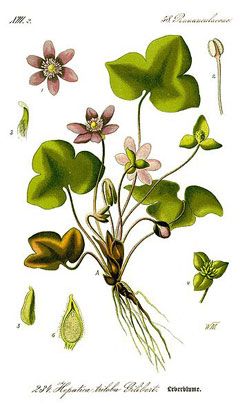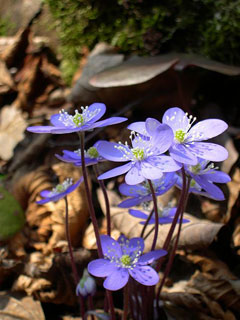 |
|
http://www.biolib.de/ |
 |
| http://commons.wikimedia.org/wiki/User:Archenzo |
Translate this page:
Summary
Physical Characteristics

 Hepatica nobilis is a PERENNIAL growing to 0.1 m (0ft 4in) by 0.1 m (0ft 4in).
Hepatica nobilis is a PERENNIAL growing to 0.1 m (0ft 4in) by 0.1 m (0ft 4in).
See above for USDA hardiness. It is hardy to UK zone 5 and is not frost tender. It is in flower from February to March. The species is hermaphrodite (has both male and female organs) and is pollinated by Bees, flies, beetles, Lepidoptera (Moths & Butterflies).
Suitable for: light (sandy), medium (loamy) and heavy (clay) soils. Suitable pH: mildly acid, neutral and basic (mildly alkaline) soils and can grow in very alkaline soils.
It can grow in full shade (deep woodland) semi-shade (light woodland) or no shade. It prefers moist soil.
UK Hardiness Map
US Hardiness Map
Synonyms
H. triloba. Anemone hepatica. L.
Plant Habitats
Woodland Garden Dappled Shade; Shady Edge; not Deep Shade;
Edible Uses
References More on Edible Uses
Medicinal Uses
Plants For A Future can not take any responsibility for any adverse effects from the use of plants. Always seek advice from a professional before using a plant medicinally.
Astringent Demulcent Diuretic Rubefacient Tonic Vulnerary
The leaves and flowers are astringent, demulcent, diuretic, rubefacient, tonic and vulnerary[4, 7, 9, 21]. It is a mild remedy that is little used in modern herbalism, but it is sometimes employed in treating disorders of the liver and gall bladder, indigestion etc[4, 238]. Externally, it is applied to skin diseases, slow healing cuts etc[4, 9]. The plant should be harvested in March and April, it can also be dried for later use[4]. Use with caution[21], see notes above on toxicity.
References More on Medicinal Uses
The Bookshop: Edible Plant Books
Our Latest books on Perennial Plants For Food Forests and Permaculture Gardens in paperback or digital formats.

Edible Tropical Plants
Food Forest Plants for Hotter Conditions: 250+ Plants For Tropical Food Forests & Permaculture Gardens.
More

Edible Temperate Plants
Plants for Your Food Forest: 500 Plants for Temperate Food Forests & Permaculture Gardens.
More

More Books
PFAF have eight books available in paperback and digital formats. Browse the shop for more information.
Shop Now
Other Uses
References More on Other Uses
Cultivation details
Prefers a deep light alkaline soil with leafmould[200, 238]. Another report says that it grows best in a deep loam or clay soil[4]. Grows well on limey woodland soils in half shade, though it also succeeds in deep shade and in full sun[1]. A very ornamental plant[1]. It grows well in the rock garden[1] and in the woodland[188]. Plants resent root disturbance and should be placed in their permanent positions as soon as possible[188]. A greedy plant, inhibiting the growth of nearby plants, especially legumes[54].
References Carbon Farming Information and Carbon Sequestration Information
Temperature Converter
Type a value in the Celsius field to convert the value to Fahrenheit:
Fahrenheit:
The PFAF Bookshop
Plants For A Future have a number of books available in paperback and digital form. Book titles include Edible Plants, Edible Perennials, Edible Trees,Edible Shrubs, Woodland Gardening, and Temperate Food Forest Plants. Our new book is Food Forest Plants For Hotter Conditions (Tropical and Sub-Tropical).
Shop Now
Plant Propagation
Seed - sow in a moist soil in a shady position[1]. The stored seed requires stratification for about 3 weeks at 0 - 5°c. Germination takes 1 - 12 months at 10°c. It is probably worthwhile sowing the seed as soon as it is ripe in a shady position in a cold frame. When they are large enough to handle, prick the seedlings out into individual pots and grow them on in the greenhouse for at least their first winter. Plant them out into their permanent positions in late spring or early summer, after the last expected frosts. Division just as the leafless plant comes into flower in late winter. Replant immediately into their permanent positions.
Other Names
If available other names are mentioned here
Native Range
EUROPE: Denmark, Finland, United Kingdom, Norway, Sweden, Austria, Belgium, Switzerland, Czech Republic, Germany, Hungary, Liechtenstein, Poland, Slovakia, Belarus, Estonia, Lithuania, Latvia, Moldova, Ukraine, Albania, Bulgaria, Bosnia and Herzegovina, Greece, Croatia, Italy, Montenegro, Romania, Serbia, Slovenia, Spain, France
Weed Potential
Right plant wrong place. We are currently updating this section.
Please note that a plant may be invasive in one area but may not in your area so it's worth checking.
Conservation Status
IUCN Red List of Threatened Plants Status :

Growth: S = slow M = medium F = fast. Soil: L = light (sandy) M = medium H = heavy (clay). pH: A = acid N = neutral B = basic (alkaline). Shade: F = full shade S = semi-shade N = no shade. Moisture: D = dry M = Moist We = wet Wa = water.
Now available:
Food Forest Plants for Mediterranean Conditions
350+ Perennial Plants For Mediterranean and Drier Food Forests and Permaculture Gardens.
[Paperback and eBook]
This is the third in Plants For A Future's series of plant guides for food forests tailored to
specific climate zones. Following volumes on temperate and tropical ecosystems, this book focuses
on species suited to Mediterranean conditions—regions with hot, dry summers and cool, wet winters,
often facing the added challenge of climate change.
Read More
Expert comment
Author
Mill.
Botanical References
50200
Links / References
For a list of references used on this page please go here
Readers comment
© 2010, Plants For A Future. Plants For A Future is a charitable company limited by guarantee, registered in England and Wales. Charity No. 1057719, Company No. 3204567.